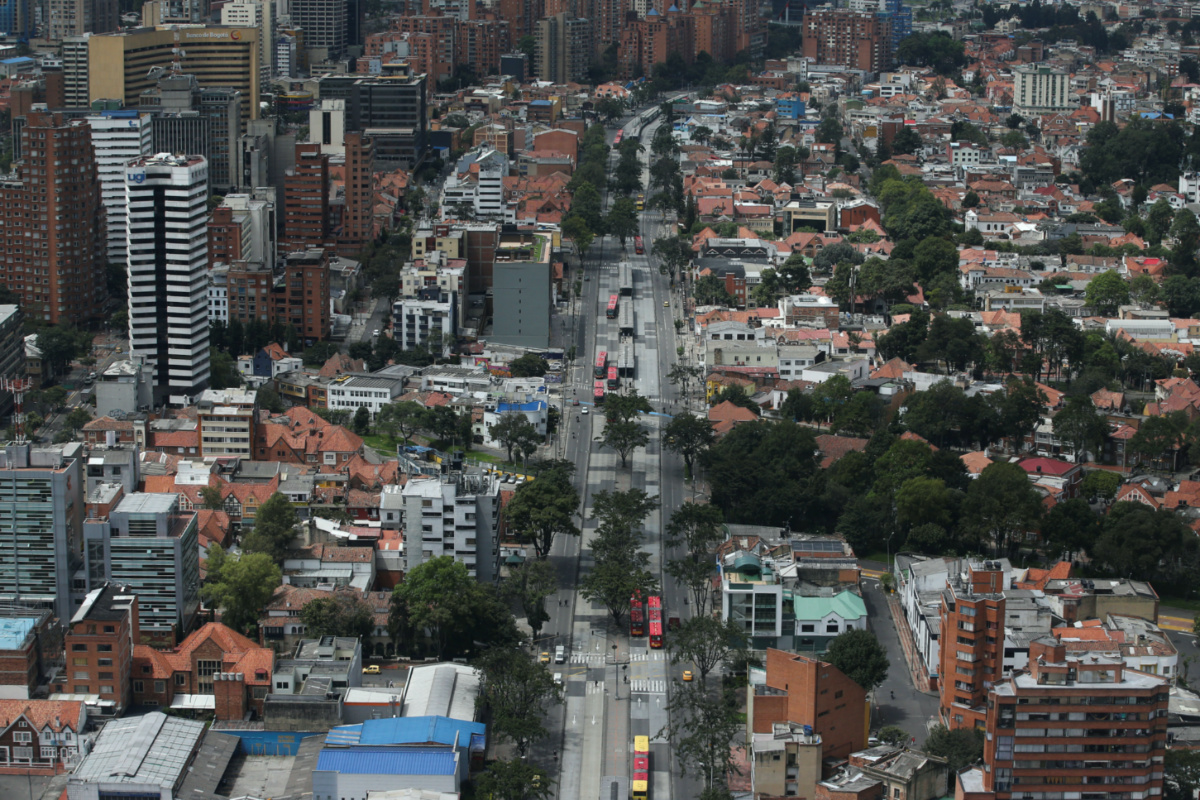Durban, South Africa
Thomson Reuters Foundation
Tackling climate change at a city level – let alone on a global scale – is time-consuming, but neighbourhoods are being targeted as testing grounds for speedy, community-led climate solutions.
Ahead of the UN Climate Change Conference (COP26) in November, engineering company Arup and the C40 Cities network have launched a guidebook for urban planners, policy makers and citizens on how to make city neighbourhoods cleaner and greener.
“There needs to be [climate] action at all levels ” said Ben Smith, a director at Arup and a co-author of the guidebook.
“We can win hearts and minds at a community level, when people are out campaigning to make their place a bit better,” he told the Thomson Reuters Foundation in an interview.

An aerial view shows the streets of Bogota, Colombia, on 7th April, 2020. Bogota is one of a number of cities where authorities are implementing solutions to tackle carbon emissions. PICTURE: Reuters/Luisa Gonzalez/File photo.
The guidebook follows the launch of a landmark report in August by a UN climate panel (IPCC), which warned that global warming was dangerously close to spiralling out of control.
From a renovated railway station in Japan to rooftop gardens in Italy, here are six examples of neighbourhoods worldwide planning and implementing solutions to tackle carbon emissions:
Bogota, Colombia
In Colombia’s capital, Barrios Vitales is hailed as the vision of a ’15-minute city’ structure connecting 30 neighbourhoods through green corridors and public spaces.
The decentralised urban model would allow residents to get from home to shops, offices, and schools within 15 minutes through quality public transport, cycling, and walking lanes.
Barrios Vitales plans to transform the ground floors of buildings into retail spaces to boost the local economy, while cutting commuting times and carbon emissions from vehicles.
Bogota is piloting the approach and plans regulatory changes to ensure the success of the strategy in the near future.
Cape Town, South Africa
South Africa’s dependency on coal is being challenged at a local level, as Cape Town promotes the uptake of solar panels and small wind turbines by businesses and residents alike.
Companies and citizens act as green energy producers and can sell excess energy into the electricity grid with an interactive map that helps them find out where and how to contribute.
The city has also subsidised solar panel installation training for South Africans to tackle both unemployment and carbon emissions.
Milan, Italy
L’Innesto is the first zero carbon housing project proposal in Italy, which will be powered by renewable energy, built with organic materials, and house rooftop gardens on the site of an old railway terminal.
The Milan initiative will limit parking space and prioritise shared vehicle use, bicycles, and electric cars, while rainwater and wastewater will be harvested, treated, and reused on site.
The aim is for L’Innesto to be carbon neutral by 2050 – and act as a blueprint for the rest of the country.
Portland, United States
The South Waterfront District in Portland – Oregon state’s largest city – is a former industrial site being transformed into 2,500 houses and mixed-use, high rise infrastructure.
The project also aims to create jobs as the Oregon Health Science University and biotech industry expand into the area, creating thousands of roles in the low-carbon neighbourhood.
Garden rooftops capture water and heat while the transport network connects residents to pedestrian and bicycle lanes, as well as public transport. Construction for the South Waterfront District started in the early 2000s and now boasts a dog park, a farmers market, and regular community events from live music to litter cleanups.
Rotterdam, The Netherlands
Rotterdam’s “water square” was built in 2014 to capture rainwater that previously overwhelmed the densely populated Dutch city’s stormwater infrastructure, according to the educational charity the Water Environment Federation.
The square has a storage capacity of almost 2 million litres of water – equivalent to about 8,500 bathtubs.
In drier months, when the water flows to nearby canals or is drained into the ground, the empty square and surrounding neighbourhoods become community hubs for markets, as well as church groups, skaters and gardeners wanting to green the city.
Tokyo, Japan
The Shinagawa Development Project in Tokyo plans to transform a former railyard site into multiple blocks of offices, housing, community centres, and shops.
The development is being built with insulated materials to reduce heat loss and will use biogas to maintain the buildings’ energy systems.
The first phase of the project – expected to be completed in the next three years – includes the Takanawa Gateway Station, which is powered by solar panels and small wind turbines.






